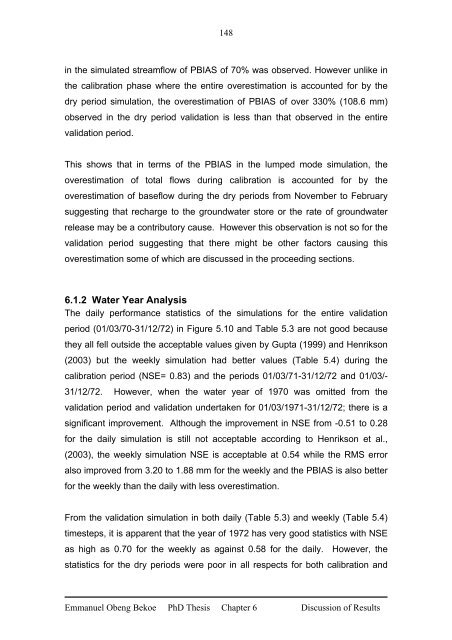PhD Thesis Emmanuel Obeng Bekoe - Cranfield University
PhD Thesis Emmanuel Obeng Bekoe - Cranfield University
PhD Thesis Emmanuel Obeng Bekoe - Cranfield University
You also want an ePaper? Increase the reach of your titles
YUMPU automatically turns print PDFs into web optimized ePapers that Google loves.
148<br />
in the simulated streamflow of PBIAS of 70% was observed. However unlike in<br />
the calibration phase where the entire overestimation is accounted for by the<br />
dry period simulation, the overestimation of PBIAS of over 330% (108.6 mm)<br />
observed in the dry period validation is less than that observed in the entire<br />
validation period.<br />
This shows that in terms of the PBIAS in the lumped mode simulation, the<br />
overestimation of total flows during calibration is accounted for by the<br />
overestimation of baseflow during the dry periods from November to February<br />
suggesting that recharge to the groundwater store or the rate of groundwater<br />
release may be a contributory cause. However this observation is not so for the<br />
validation period suggesting that there might be other factors causing this<br />
overestimation some of which are discussed in the proceeding sections.<br />
6.1.2 Water Year Analysis<br />
The daily performance statistics of the simulations for the entire validation<br />
period (01/03/70-31/12/72) in Figure 5.10 and Table 5.3 are not good because<br />
they all fell outside the acceptable values given by Gupta (1999) and Henrikson<br />
(2003) but the weekly simulation had better values (Table 5.4) during the<br />
calibration period (NSE= 0.83) and the periods 01/03/71-31/12/72 and 01/03/-<br />
31/12/72. However, when the water year of 1970 was omitted from the<br />
validation period and validation undertaken for 01/03/1971-31/12/72; there is a<br />
significant improvement. Although the improvement in NSE from -0.51 to 0.28<br />
for the daily simulation is still not acceptable according to Henrikson et al.,<br />
(2003), the weekly simulation NSE is acceptable at 0.54 while the RMS error<br />
also improved from 3.20 to 1.88 mm for the weekly and the PBIAS is also better<br />
for the weekly than the daily with less overestimation.<br />
From the validation simulation in both daily (Table 5.3) and weekly (Table 5.4)<br />
timesteps, it is apparent that the year of 1972 has very good statistics with NSE<br />
as high as 0.70 for the weekly as against 0.58 for the daily. However, the<br />
statistics for the dry periods were poor in all respects for both calibration and<br />
<strong>Emmanuel</strong> <strong>Obeng</strong> <strong>Bekoe</strong> <strong>PhD</strong> <strong>Thesis</strong> Chapter 6 Discussion of Results

















